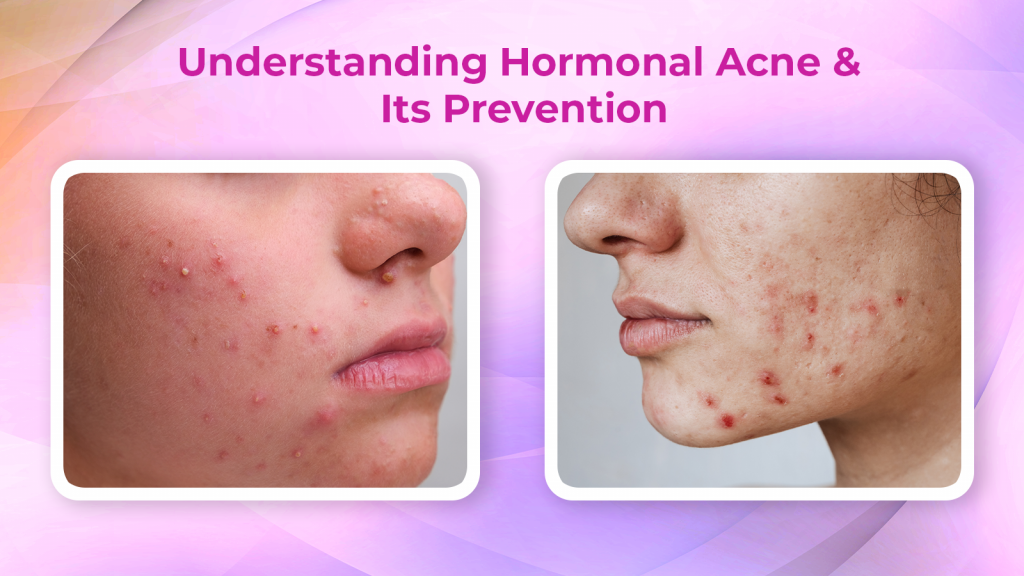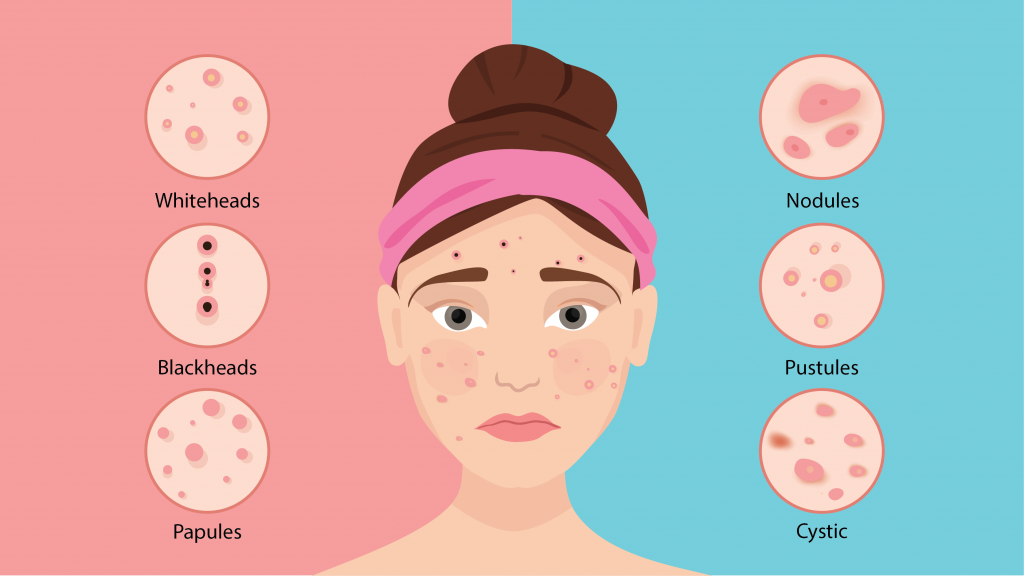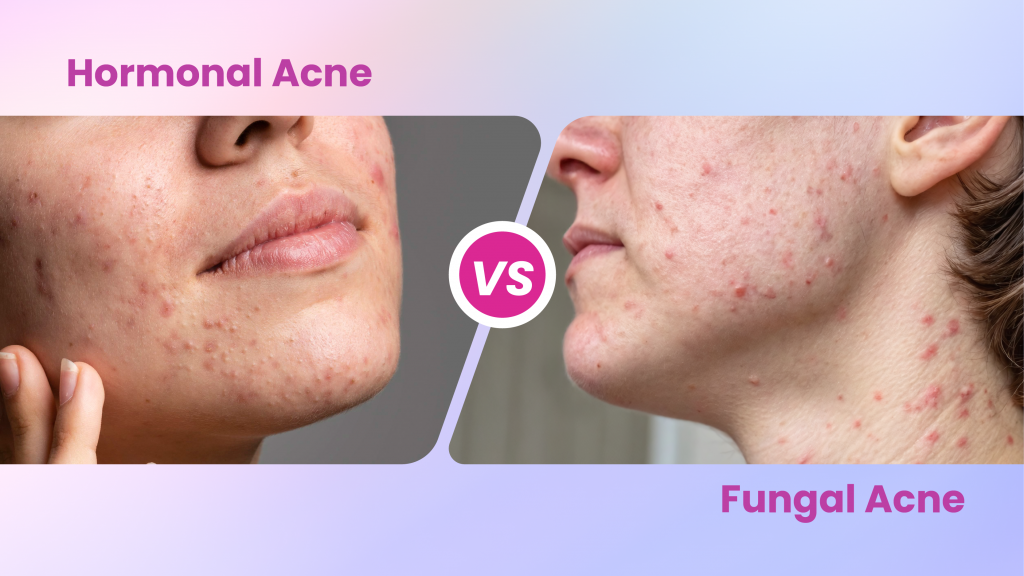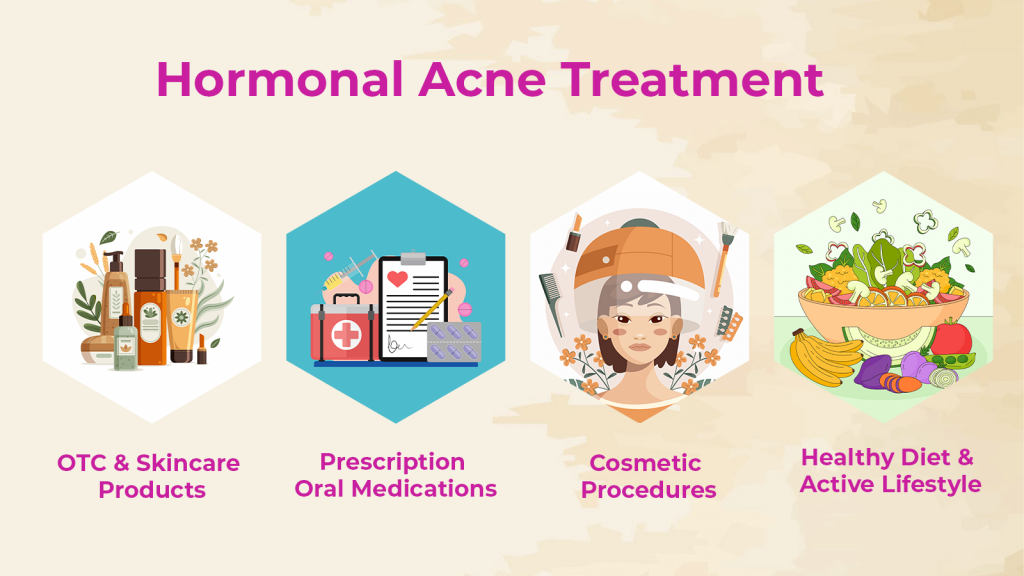In this Article
What is hormonal acne? How can you prevent it?
What are the root causes of hormonal acne?
What does hormonal acne look like?
Hormonal acne vs fungal acne: What’s the difference?
How to prevent and control hormonal acne?
Prescription oral treatments and cosmetic procedures
What is Hormonal Acne? How Can You Prevent It?

The thought of painful, inflamed and pus-filled acne breakouts can instantly gross somebody out. These enormous-looking pimples are called ‘hormonal acne’, which can result from a combination of reasons like insulin spikes, high cortisol levels, puberty, poor diet, and lack of physical activity.
The major cause of these lesions is hormonal fluctuations. While all of these may sound baffling, this blog emphasises what hormonal acne is, what causes it, and how to prevent it with natural remedies and medical treatments. Read to know more.

Reviewed by Dr. Swarnali Maiti
MBBS, MD in Dermatology, Venerelogy & Leprosy
Updated on: July 5, 2025
What is Hormonal Acne?
Hormonal acne, or commonly known as adult acne, is directly caused by the presence of excess sebaceous (oil) glands, and is commonly found to affect men and women between the ages of 20 and 50. The blockage of pores caused by sebum, dirt or product buildup can cause acne.
Hormonal acne could cause bumps on an individual’s face, chest, shoulders, and back in the form of cysts, pimples, whiteheads and blackheads. It is to be noted that hormonal imbalance acne is more common in women than in men, research showing that approximately 80.9% of women are predominantly affected when compared to the 19.1% of male adult acne patients.
What are the Root Causes of Hormonal Acne?
Firstly, it is to be noted that hormonal acne patients experience more breakouts in the following phases:
- Pre or during menstruation
- Upon consuming or stopping contraceptive pills
- During or post-pregnancy
- At menopause or during perimenopause.
To understand which hormones play a role in causing acne, researchers surmise that the hormone androgen can be linked to the condition. While androgens are found in both males and females, the concentration is lower in case of women. The presence of excess androgens in women causes the oil glands to produce uncontrollably more sebum than usual, hence, inducing acne flare-ups.
Thereafter, the level of androgen (the hormone that causes acne in females) in the body can increase because of the following factors:
- Puberty
- High cortisol levels (due to stress)
- Medical conditions like Polycystic Ovary Syndrome (PCOS) or Polycystic Ovarian Disease (PCOD)
- Menstruation
- Disrupted sleep schedule
- Intake of certain medicines like birth control pills
- Pregnancy or menopause
- Family history of hormonal acne
Nonetheless, androgen hormone levels in the body (both men and women) can also increase due to poor dietary choices such as dairy, gluten and sugar.
What Does Hormonal Acne Look Like?

Hormonal acne symptoms can manifest as painful, deeper papules, pustules, cysts and nodules on one’s lower cheeks, jawline and chin. Some signs can also occur as non-itchy whiteheads and blackheads. These damaged skin tissues or lesions can appear red, be filled with pus and even feel sore just by the thought of touching the affected area.
Besides one’s face, neck, back, chest, and shoulders are other common areas where hormonal acne may occur. Picking at the blemishes or squeezing them can worsen the condition, transferring the germ to other nearby areas.
Hormonal Acne Vs. Fungal Acne: What’s the Difference?

Hormonal imbalance acne may often be mistaken for fungal acne, as both occur in the hair follicles; however, they have distinctive characteristics. Hormonal imbalances lead to the production of excess sebum, hence causing clogged pores and hormonal acne.
On the other hand, the overdevelopment of Malassezia yeast on the skin impacts the hair follicles and results in a cluster of small, often with red borders, uniform, itchy bumps on the forehead, chin, cheeks, upper back, shoulders and chest.
Antifungal treatments are ideal for managing fungal acne, whereas hormonal acne responds well to targeted sebum-regulating treatments.
How to Prevent and Control Hormonal Acne?

The treatment of adult acne involves a combination of natural and medical fixes. While using topical creams may reduce sebum production and inflammation of lesions, it is essential to fix hormonal fluctuations from within as well.
Take a look at the following hormonal acne remedies that a professional may recommend based on the severity of the acne:
OTC Products & Skincare
-
Topical Retinoids
Retinoids belong to the family of Vitamin A derivatives, which can help treat skin conditions like psoriasis and acne, reduce the appearance of signs of ageing, and improve skin texture.
Mild to moderate acne can be treated well with these OTC retinoids:
- Adapalene
- Tretinoin
- Trifarotene
- Tazarotene
While these retinoids are easily available at pharmacies, it is paramount to consult with a doctor before using them to avoid potential skin complications. Also, these hormonal acne creams can come in the form of gel or cream, and should be applied strictly in the evening.
-
Skincare Actives
Commonly used skincare actives like salicylic acid and benzoyl peroxide are other relevant topical hormonal acne treatments. One can use a foaming salicylic acid face wash daily twice in the morning and evening, while using a benzoyl peroxide gel in the evening after cleansing, followed by a non-comedogenic face cream.
Prescription Oral Treatments & Cosmetic Procedures
-
Oral Medications
Oral antibiotics, including doxycycline, tetracycline and minocycline, can help reduce the inflammation and redness caused by pustule or cystic acne. Another potent oral medication for preventing and controlling hormonal acne includes isotretinoin.
Isotretinoin (Accutane) is a strong retinoid which is often suggested as a last-resort treatment option by professionals for patients with moderate to severe and persistent hormonal cystic acne. It functions by controlling sebum production, reducing inflammation and preventing clogging of hair follicles.
-
Anti-Androgen Pills
Anti-androgen drugs like spironolactone stabilise the hormone receptors, regulating the androgen count in females. This prevents the hormone from affecting hair follicles and increasing sebum.
Contraceptive (birth control) pills containing ethinyl estradiol, norethindrone, drospirenone and norgestimate together can block the androgen hormone, causing adult acne, and especially benefit women during the ovulation phase in their menstrual cycle.
Other anti-androgen medications include ingredients like cyproterone and metformin, which can help regulate hormonal fluctuations and control acne.
-
Chemical Peels
A non-invasive, dermatological acne treatment that uses a safe chemical solution chemically formulated to exfoliate the skin on a deeper level. This exfoliation helps unclog pores, hence preventing breakouts and even ensuring a smoother, clearer complexion. Professional-grade chemical peels also relieve patients from acne inflammation.
-
Laser Therapy
Laser treatment is an ideal choice for individuals seeking drug-free treatment. It works by targeting sebum glands, shrinking them and reducing excess oil, hence preventing clogging of pores. It also helps calm hormonal acne-related inflammation and further reduces the appearance of post-acne dark spots.
Diet Tweaks That Matter
Hormonal acne diet involves specific food choices that can help reduce acne-related inflammation, manage insulin spikes, and stabilise blood sugar levels. Let’s take a look at the food that one can include to regulate hormonal fluctuations:
-
Anti-Inflammatory Options :
Berries, nuts, sardines, salmon, chia seeds, walnuts, flaxseeds and leafy greens reduce oxidative stress and promote skin health.
-
Whole Grains and Legumes :
Opt for brown rice, whole wheat and quinoa over refined carbs to avoid an insulin spike. Similarly, choose good sources of fibre like beans and legumes to control blood sugar.
-
Plant-Based Dairy :
Almond milk, soy milk, and oat milk are excellent alternatives to cow milk and can help prevent hormonal acne flare-ups.
-
Fruits :
Apples, plums, papayas, and grapes should be included in the diet to limit the consumption of sugary fruits.
-
Protein-Overloaded Breakfast :
Besan chila, chicken salad, or an oats bowl in the morning can help regulate blood sugar and contribute to healthy skin.
Lifestyle Habits to Prevent Hormonal Acne Imbalance
- Avoid high-glycemic foods (like white bread, pastries and sugary drinks), dairy, fried and processed foods, refined carbs and excess sugar.
- Stay hydrated throughout the day by drinking plenty of fluids, as this will help detox the body of toxins.
- Maintain a healthy sleep schedule, ensuring you get 7-8 hours of sleep daily.
- Manage stress and keep your body active by practising yoga and meditation, or working out daily.
- Check for comedogenic ingredients in makeup and skincare products and switch to non-comedogenic ones.
- Ensure cleansing the face thoroughly after a physical activity to avoid clogged pores.
- Remove makeup before going to bed to prevent dirt and product buildup.
- Avoid picking at the blemishes or touching the face to minimise the risk of bacteria and oil transfer
When to See a Dermatologist?
If hormonal acne persists even after using topical creams, following a healthy lifestyle and consuming a hormonal acne-friendly diet, seek professional advice from a reputable dermatologist. At Wizderm, our expert team of doctors offer a detailed skin analysis, helping you understand the root causes of acne and offer appropriate and customised treatment plans. Book your consultation today at Wizderm Skin and Hair Clinic!
FAQ
Can hormonal acne appear suddenly in adulthood?
Yes, hormonal acne is also called ‘adult acne’, as it mainly affects men and women between the ages of 20 and 50, specifically after hitting puberty.
Does hormonal acne always show up in the same place?
No, hormonal acne can show up on one’s face (lower cheeks, chin and jawline), shoulders, back and even chest.
Can stress alone trigger hormonal acne?
While stress is one of the major triggering factors of hormonal acne, flare-ups can also be caused due to an increase in androgen hormones in the body, a diet rich in high glycemic foods and dairy, and a lack of involvement in physical activity.
How long does it take for hormonal acne treatment to show results?
The speed at which outcomes show up depends on the individual’s skin type, severity of the acne lesions and the treatment type. However, topical treatments can take up to 6 – 8 weeks to show visible changes with consistent use, while clinical procedures, such as chemical peels, can yield results much faster, often in just a few sessions.
Can men get hormonal acne, too?
Yes, hormonal acne can affect both men and women, and treatments are available for both genders.
Is it safe to pop hormonal acne cysts?
Absolutely not! Popping or picking at the hormonal acne cysts can cause transfer of the bacteria or oil across the nearby areas and lead to further breakouts.
Do dairy and sugar really make hormonal acne worse?
Yes, dairy and sugar can worsen hormonal acne by increasing androgen and insulin levels, thereby boosting sebum production and inflammation. This, therefore, leads to more breakouts.
Can I treat hormonal acne naturally without medication?
Yes, it is very likely to treat mild to moderate hormonal acne with only topical retinoids, chemical peels, healthy lifestyle habits, and dietary tweaks, eliminating the need to consume medications.
Does birth control work for hormonal acne, and is it worth it?
Yes, birth control pills regulate the androgen hormones that trigger acne in women, reducing breakouts and inflammation. However, one must strictly consult with a doctor about its usage, especially if the acne condition is moderate to severe.



